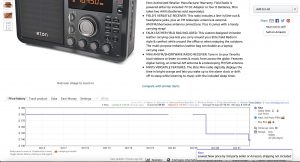Many thanks to SWLing Post contributor, Peter Laws, who shares the following guest post:
 Thomas is Famous!
Thomas is Famous!
by Peter Laws
A few weeks ago, a summary of the recent change to Title 47 of the Code of Federal Regulations, Part 95, Subpart D — better known as the rules for the CB Radio Service — was published here. That change, following a successful petition for reconsideration of a previous petition allowed FM as an additional mode in the CB Radio Service. The original petition was the one that caused the FCC to do away with the nearly-impossible-to-enforce “DX Rule” that prohibited communications of more than 250 km. For one, the ionosphere had a long history of ignoring the rule entirely, at least for part of the Sun’s eleven-year cycle.
In that article, the author speculated that it may not be too long before manufacturers brought radios that were capable of FM to market, since they already existed in other markets, namely countries that were members of CEPT.
That author has been watching the FCC OET site to see who will be the first out of the gate to get an FM CB approved. The Office of Engineering and Technology is the FCC’s line office that handles, among other things, Equipment Authorization. They also handle Experimental Licensing, i.e., “Part 5”, like the recent 630- and 2200-m band projects that resulted in new Amateur Radio allocations and the ongoing 8-m band experiments under WL2XUP (see that license’s details at https://apps.fcc.gov/oetcf/els/reports/CallsignSearch.cfm).
OET also provides a public database of equipment authorizations. If you know a radio device’s “FCC ID” (usually an alpha-numeric string found on the label of a device or in the device’s documentation), you can look up the details in the database. A manufacturer’s ID — the first 3 to 5 characters of a product’s ID — will show all the devices that have been authorized. Fortunately, you can limit the search by date as by frequency range. https://apps.fcc.gov/oetcf/eas/reports/GenericSearch.cfm Authorizations available online go back into the 1990s but the further back the results go, the less detailed they become.
So who won the race to bring the first FM-capable CB radio to the US market or at least to get a product authorized? Our benefactor, Mr Witherspoon, will be thrilled to hear that the first radio to gain FCC authorization is the President Thomas FCC!
As soon as President Electronics can get stock to distributors, the radio should be available. This writer has no information about when that may happen.
The President Thomas FCC is an older design (c.2013), meaning that whatever R&D costs President Electronics had for the bulk of the design will have been amortized years ago. As noted in the previous article, changes for conformity with the FCC Part 95 rules are expected to be minimal and likely have to do with locking out the “multi-norm” ability in the new model’s European counterpart. Following FCC rules, this is an AM radio that has FM as well. The new Part 95 regulations require AM in every radio with FM as a possible option.
Several websites have details on the existing President Thomas ASC (ASC is automatic squelch control). [See photos above.] It’s a multi-norm radio as is common in the European market and offers CEPT channels, UK channels, and Polish channels among others. CEPT channels are identical to the FCC allocations, UK channels are completely different though still between 27 and 28 MHz, and Polish channels are exactly like the FCC channels except that they are all 5 kHz lower (i.e., our Channel 19 is 27.185 while their Channel 19 is 27.180). Here is an example of a site with data on the European version: http://www.cbradio.nl/president/thomas.htm
FCC authorization was long ago turned over to contract labs. Here is the Equipment Authorization for the President Thomas FCC:
Peter Laws









